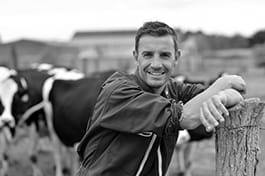Profession livestock worker

Livestock farm helpers attend to live farm animals, e.g. cattle, sheep, pigs, horses and poultry. Their duties may include e.g. feeding, watering, herding, grooming, weighing, catching and loading animals.
Livestock worker Jobs: Open positions
Find the job of your dreams on Talent.com, one of the largest job sites worldwide.
Job postings: talent.comPersonality Type
Tasks livestock worker
- Herd or move livestock to desired locations, e.g. pastures for grazing, or to scales, lorries and enclosures.
- Weigh and measure foodstuffs, and mix feed, additives and medicines in prescribed portions.
- Monitor food and water supplies, and distribute feed and water to livestock.
- Drive lorries, tractors and other equipment.
- Clean barns, sheds, pens, yards and equipment, e.g. using disinfectant solutions, brushes, shovels, water hoses, pumps, etc.
- Groom, clip, trim, shoe and castrate animals, dock ears and tails, shear coats to collect hair, and mark livestock to identify ownership and grade using brands, tags, paint or tattoos.
- Milk animals, such as cows and goats, and collect eggs, honey, etc.
- Examine animals to detect illness, injury or disease, and to check physical characteristics, such as rate of weight gain.
- Care for sick animals, treat minor ailments and administer medications, vaccinations or insecticides as appropriate.
- Perform duties related to livestock reproduction, such as breeding animals within appropriate timeframes, performing artificial inseminations and helping with animal births.
- Keep records on animals, e.g. about feeding and breeding.
- Maintain farm machinery and buildings.
Related professions livestock
- Agricultural advisor
- Arable farm manager, field crop or vegetable
- Arable farmer manager, mixed crop
- Artificial inseminator
- Cattle breeder
- Cattle station helper
- Dairy producer
- Herdsman
- Livestock breeder, all other
- Livestock dealer
- Livestock farm manager
- Livestock farm worker
- Livestock farmer
- Livestock machinery installer
- Livestock machinery mechanic
- Pig breeder
- Poultry producer
- Quality inspector cattle, meat, fish
- Subsistence livestock farmer
- Veterinarian inspector
- Veterinarian, all other
- Veterinary aid
- Veterinary practitioner
- Veterinary technician
- Veterinary vaccinator
Knowledge
- Computerised feeding systems
The functioning of computered controlled systems that provide animal feeding.
- Animal nutrition
Aspects of how different animal species are fed and provided water. Different types of animal food, the quality criteria for animal food and methods to feed and give water to animals.
- Livestock feeding
Food given to domestic animals in the course of animal husbandry.
- Biology
Tissues, cells, and functions of plant and animal organisms and their interdependencies and interactions with each other and the environment.
- Agronomical production principles
The techniques, methods and principles of conventional agronomical production.
Skills
- Breed stock
Breed and raise livestock such as cattle, poultry, and honeybees. Use recognised breeding practices to strive for continuous improvement in the livestock.
- Control livestock disease
Control the spread of disease and parasites in herds, by using vaccination and medication, and by separating sick animals.
- Maintain pastures
Ensure that animals on pastures or grazing lands have enough feed. Employ pasture-conservation measures such as grazing in rotation.
- Perform farm equipment hygiene
Clean and sanitise equipment used in milking: milk storage tanks, collection cups, and udders of the animals. Ensure that procedures for the sanitary handling of milk are followed.
- Operate agricultural machinery
Operate motorised agricultural equipment including tractors, balers, sprayers, ploughs, mowers, combines, earthmoving equipment, trucks, and irrigation equipment.
- Manage the health and welfare of livestock
Assess the current health status of your livestock. Manage any existing disease or disorder, including the requirements for isolation of livestock. Plan and manage a livestock health and welfare plan including clearly defined targets, consulting with specialists/advisers where appropriate. Work closely with the veterinary surgeon and other specialist consultants/advisers.
- Assist animal birth
Assist in animal births, and care for newborn livestock.
- Maintain the farm
Maintain farm facilities such as fences, water supplies, and outdoor buildings.
- Maintain farm equipment
Use oil, grease guns, and hand tools to lubricate, adjust, and make minor repairs to farm equipment.
Optional knowledge and skills
harvest crop maintain linen operation arrange tables manage farm supplies train horses dock tails manage crop production store raw food materials shearing of wool slaughter fur animals skin animals catch poultry on a farm raise hens manage grain storage install irrigation systems present the farm facilities handle feathers process dairy farm products monitor crops order supplies cut teeth process harvested honey direct the preparation of food agritourism milk animals operate dairy farms equine dental diseases serve food in table service perform milk control monitor the production of eggs clean rooms carry out specialised procedures for pigsSource: Sisyphus ODB